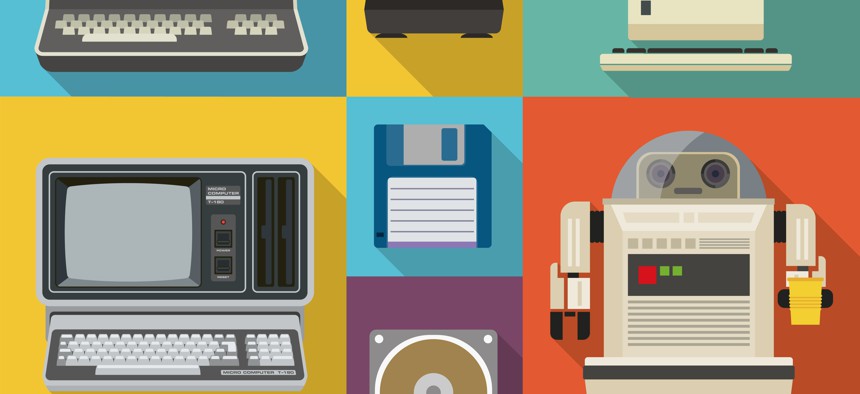sponsor content What's this?
How Does Working with Legacy IT Affect Feds’ Day-to-Day Jobs?

Presented by
FedTech

A Dell study found that 71 percent of federal IT decision makers say their agency runs important applications on old operating systems.
The idea that the federal government needs to modernize its IT is not a surprise, but the extent to which it depends on outdated technology is notable, according to a new survey from Dell. Federal IT workers who need to rely on legacy IT also lose out on developing new skills with modern technologies, and need to spend time maintaining those older systems, according to a top Dell executive.
Top federal IT leaders, from federal CIO Tony Scott on down, have been beating the drum for years on the need to update legacy IT systems, especially as a way to improve the government’s cybersecurity posture, since older systems often create more security vulnerabilities.
Yet according to a recent study sponsored by Dell, which surveyed 100 federal government IT decision makers and business decision makers, 71 percent say they are currently using old operating systems to run important applications, and most report using old versions of Windows, namely Windows 7 or 8 (61 percent).
Federal respondents listed IT infrastructure systems (46 percent) and file storage/collaboration systems (39 percent) as the ones most in need of modernization or replacement.
When asked what concerned them most about legacy hardware and software used at their agencies, 42 percent cited the cybersecurity risks of the legacy IT, 19 percent pointed to the cost of supporting the systems and 16 percent said the old systems were constraining their ability to modernize.
How Legacy IT Affects Feds
In an interview with FedTech, Cameron Chehreh, Dell Federal’s chief technology officer, said that many agency-specific applications were built on legacy operating systems, some of which are no longer officially supported for security patches. “From a cybersecurity perspective, the risk to the national mission has become much more significant,” he said.
The opportunity to migrate to Microsoft’s Windows 10 platform represents “much more than an operating system upgrade,” Chehreh said, adding that it will let agencies remove complexity, reduce cybersecurity risks and increase agencies’ abilities to deliver higher levels of service, whether they are civilian agencies or not.
“This really is about endpoint transformation,” he said. Windows 10 provides agencies with “a new hardened operating system on hardened hardware to be able to really protect in a new manner the largest attack surface in the enterprise, which is the end-user endpoint.”
Further, by moving to new 2-in-1 devices and tablets running Windows 10, agencies that send many workers into the field, like the Federal Emergency Management Agency and the Environmental Protection Agency, will be giving users cutting-edge capabilities with enhanced security, Chehreh noted.
Federal workers who need to rely on legacy IT see the impacts of that dependence on a daily basis, Chehreh said. For example, anyone who still needs to maintain a mainframe computer to run a critical application needs to have a specific skill set to do so.
According to a Government Accountability Office report from May, the Treasury Department’s taxpayer data program uses assembly language code — a low-level computer code that is difficult to write and maintain — and operates on an IBM mainframe. The department says it has general plans to replace the program, which is 56 years old, but there is no firm date associated with the transition
“It’s a very different process for service management for running IT,” Chehreh said. “Colleges aren’t teaching things like COBOL today. You are on these aged systems that require a significant amount of unique and specialized skills to run.”
Further, by spending time maintaining those legacy systems, and with younger workers learning from older colleagues who may have the necessary knowledge, federal IT workers are not using their time to gain skills for modern technologies, according to Chehreh. Such tools, especially cloud-based ones, offer IT workers new marketable skills that will let them “unlock the power of the information in all of the enterprise.”
Another challenge that comes from legacy IT and affects the day-to-day work of federal IT users is “the lowered ability to deal with mission requirements in a more rapid or agile sense,” Chehreh said.
For example, he noted, a legacy system like the Treasury one cited in the GAO report would require users to change lines of COBOL code. A modern, cloud-based system could let users accomplish the same tasks in much shorter amounts of time.
Moving Forward on IT Reforms
Scott and other federal IT leaders are pushing the ball forward on IT modernization. Speaking at FCW’s Getting the Edge on Cyber Threats Summit on Aug. 23, Scott said the Obama administration’s proposed IT Modernization Fund, which would create a $3.1 billion revolving fund to modernize IT, could be complemented by the proposed Modernizing Outdated and Vulnerable Equipment and Information Technology (MOVE IT) Act.
Chehreh praised the work of Scott and the federal CIO Council, calling it “nothing short of brilliant” and saying that Scott and other federal IT leaders have championed the cause of IT modernization effectively. He also said they have collaborated effectively among themselves not only as federal agency CIOs but also within their agencies, embedding the ethos of IT modernization into agency divisions and mission components.
“They realize that this is more than a technology challenge,” and must also involve how agencies’ procure IT.
“We’ve reached a pinnacle point,” Chehreh said. “The can can no longer be kicked down the road.”
For more on federal IT modernization, visit fedtechmagazine.com/modernIT2016.
This content is made possible by FedTech. The editorial staff of Nextgov was not involved in its preparation.


